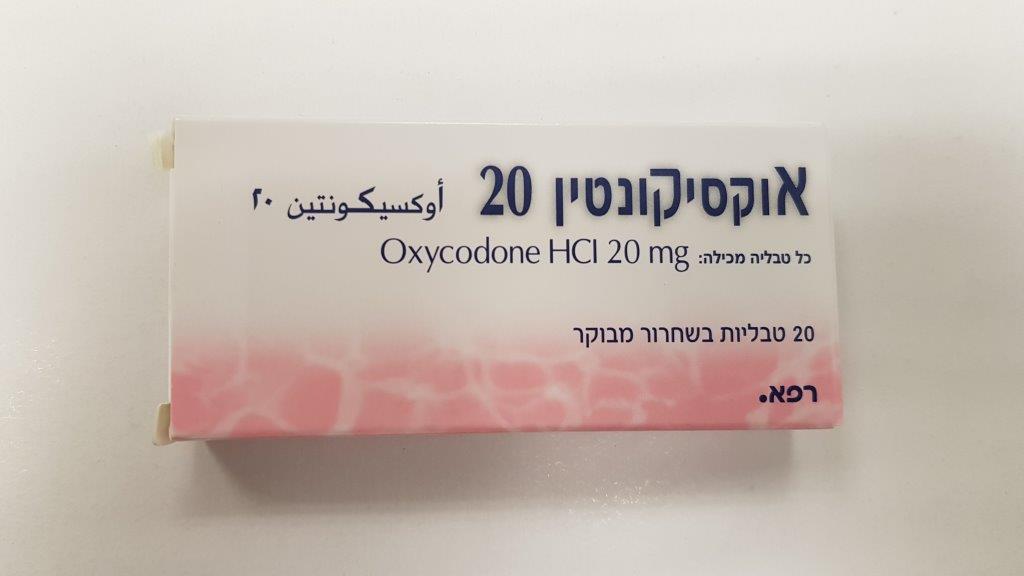Quest for the right Drug

אוקסיקונטין 20 OXYCONTIN 20 (OXYCODONE HYDROCHLORIDE)
תרופה במרשם
תרופה בסל
נרקוטיקה
ציטוטוקסיקה
צורת מתן:
פומי : PER OS
צורת מינון:
טבליות בשחרור מבוקר : TABLETS CONTROLLED RELEASE
עלון לרופא
מינוניםPosology התוויות
Indications תופעות לוואי
Adverse reactions התוויות נגד
Contraindications אינטראקציות
Interactions מינון יתר
Overdose הריון/הנקה
Pregnancy & Lactation אוכלוסיות מיוחדות
Special populations תכונות פרמקולוגיות
Pharmacological properties מידע רוקחי
Pharmaceutical particulars אזהרת שימוש
Special Warning עלון לרופא
Physicians Leaflet
Interactions : אינטראקציות
4.5 Interaction with other medicinal products and other forms of interaction The concomitant use of opioids with sedative medicines such as benzodiazepines or related drugs increases the risk of sedation, respiratory depression, coma and death because of additive CNS depressant effect. The dose and duration of concomitant use should be limited (see section 4.4). Drugs which affect the CNS include, but are not limited to: other opioids, gabapentinoids such as pregabalin, anxiolytics, hypnotics and sedatives (including benzodiazepines), antipsychotics, anti- depressants, phenothiazines, anaesthetics, muscle relaxants, antihypertensives and alcohol. Concomitant administration of oxycodone with serotonin agents, such as a Selective Serotonin Re- uptake Inhibitor (SSRI) or a Serotonin Norepinephrine Re-uptake Inhibitor (SNRI) may cause serotonin toxicity. The symptoms of serotonin toxicity may include mental-status changes (e.g., agitation, hallucinations, coma), autonomic instability (e.g., tachycardia, labile blood pressure, hyperthermia), neuromuscular abnormalities (e.g., hyperreflexia, incoordination, rigidity), and/or gastrointestinal symptoms (e.g., nausea, vomiting, diarrhoea). Oxycodone should be used with caution and the dosage may need to be reduced in patients using these medications. Concomitant administration of oxycodone with anticholinergics or medicines with anticholinergic activity (e.g. tricyclic anti-depressants, antihistamines, antipsychotics, muscle relaxants, anti-Parkinson drugs) may result in increased anticholinergic adverse effects. Oxycodone should be used with caution and the dosage may need to be reduced in patients using these medications. MAO inhibitors are known to interact with narcotic analgesics. MAO inhibitors cause CNS excitation or depression associated with hypertensive or hypotensive crisis (see section 4.4). Co-administration with monoamine oxidase inhibitors or within two weeks of discontinuation of their use should be avoided. Alcohol may enhance the pharmacodynamic effects of OxyContin; concomitant use should be avoided. Oxycodone is metabolised mainly by CYP3A4, with a contribution from CYP2D6. The activities of these metabolic pathways may be inhibited or induced by various co-administered drugs or dietary elements. Oxycodone doses may need to be adjusted accordingly. CYP3A4 inhibitors, such as macrolide antibiotics (e.g. clarithromycin, erythromycin and telithromycin), azole-antifungals (e.g. ketoconazole, voriconazole, itraconazole, and posaconazole), protease inhibitors (e.g. boceprevir, ritonavir, indinavir, nelfinavir and saquinavir), cimetidine and grapefruit juice may cause a reduced clearance of oxycodone that could cause an increase of the plasma concentrations of oxycodone. Therefore, the oxycodone dose may need to be adjusted accordingly. Some specific examples are provided below: • Itraconazole, a potent CYP3A4 inhibitor, administered 200 mg orally for five days, increased the AUC of oral oxycodone. On average, the AUC was approximately 2.4 times higher (range 1.5 - 3.4). • Voriconazole, a CYP3A4 inhibitor, administered 200 mg twice-daily for four days (400 mg given as first two doses), increased the AUC of oral oxycodone. On average, the AUC was approximately 3.6 times higher (range 2.7 - 5.6). • Telithromycin, a CYP3A4 inhibitor, administered 800 mg orally for four days, increased the AUC of oral oxycodone. On average, the AUC was approximately 1.8 times higher (range 1.3 - 2.3). • Grapefruit Juice, a CYP3A4 inhibitor, administered as 200 ml three times a day for five days, increased the AUC of oral oxycodone. On average, the AUC was approximately 1.7 times higher (range 1.1 - 2.1). CYP3A4 inducers, such as rifampicin, carbamazepine, phenytoin and St John's Wort may induce the metabolism of oxycodone and cause an increased clearance of oxycodone that could cause a reduction of the plasma concentrations of oxycodone. The oxycodone dose may need to be adjusted accordingly. Some specific examples are provided below: • St John's Wort, a CYP3A4 inducer, administered as 300 mg three times a day for fifteen days, reduced the AUC of oral oxycodone. On average, the AUC was approximately 50% lower (range 37-57%). • Rifampicin, a CYP3A4 inducer, administered as 600 mg once-daily for seven days, reduced the AUC of oral oxycodone. On average, the AUC was approximately 86% lower Drugs that inhibit CYP2D6 activity, such as paroxetine and quinidine, may cause decreased clearance of oxycodone which could lead to an increase in oxycodone plasma concentrations. Concurrent administration of quinidine resulted in an increase in oxycodone Cmax by 11%, AUC by 13%, and t 1/2 elim. by 14%. Also, an increase in noroxycodone level was observed, (Cmax by 50%; AUC by 85%, and t1/2 elim. by 42%). The pharmacodynamic effects of oxycodone were not altered.

שימוש לפי פנקס קופ''ח כללית 1994
לא צוין
תאריך הכללה מקורי בסל
01/01/2000
הגבלות
תרופה מוגבלת לרישום ע'י רופא מומחה או הגבלה אחרת
מידע נוסף
עלון מידע לצרכן
14.02.13 - עלון לצרכן 06.08.15 - עלון לצרכן אנגלית 01.08.21 - עלון לצרכן אנגלית 01.08.21 - עלון לצרכן עברית 01.08.21 - עלון לצרכן ערבית 02.11.22 - עלון לצרכן עברית 11.05.23 - עלון לצרכן אנגלית 11.05.23 - עלון לצרכן עברית 11.05.23 - עלון לצרכן ערבית 01.08.23 - עלון לצרכן אנגלית 01.08.23 - עלון לצרכן עברית 01.08.23 - עלון לצרכן ערבית 03.06.24 - עלון לצרכן עברית 05.09.24 - עלון לצרכן עברית 05.03.19 - החמרה לעלון 12.04.21 - החמרה לעלון 27.05.13 - החמרה לעלון 02.11.22 - החמרה לעלון 05.12.22 - החמרה לעלון 07.09.23 - החמרה לעלון 06.06.24 - החמרה לעלון 05.09.24 - החמרה לעלוןלתרופה במאגר משרד הבריאות
אוקסיקונטין 20